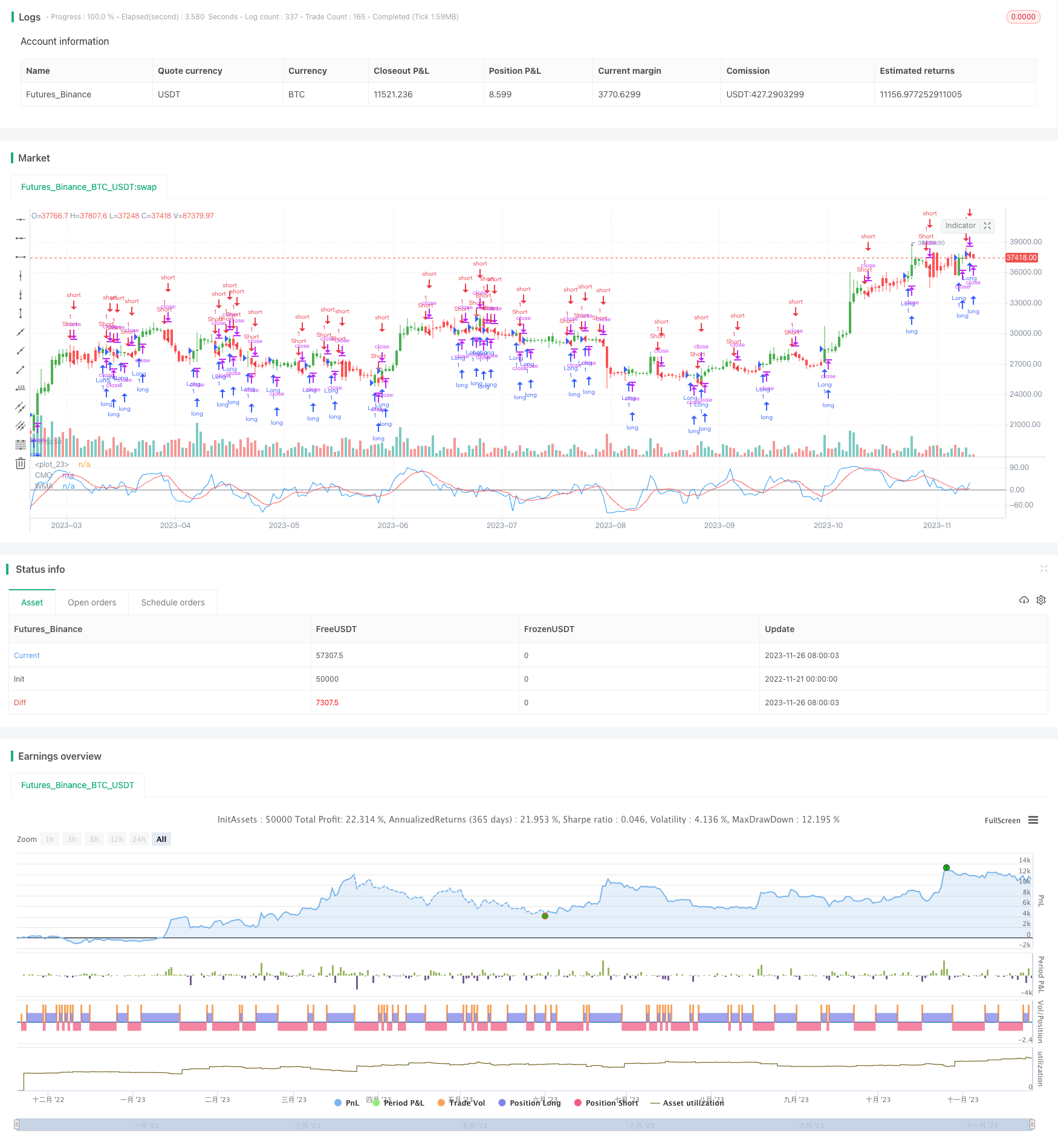
概述
该策略名称为“基于CMO和WMA的动量交易策略”。该策略利用Chande Momentum Oscillator(CMO)和其加权移动平均线(WMA)构建交易信号。核心思想是当CMO上穿其WMA时做多,下穿其WMA时做空。同时考虑反向交易的选项。
策略原理
该策略的核心指标是CMO。CMO与RSI等其他动量指标关系密切,但也有独特之处。CMO直接测量价格变化momentum。其计算基于原始未经平滑的数据,所以能反映短期极端价格变动。CMO数值范围固定在+100至-100之间,所以方便比较不同股的绝对momentum大小。
该策略首先计算 close 价格的单日变化abs(close - close[1])作为原始momentum xMom。然后计算xMom的Length天SMA,记为xSMA_mom。然后计算Length天价格变化xMomLength,即close - close[Length]。最后CMO值为xMomLength除以xSMA_mom再乘100。该CMO通过WMA(参数LengthWMA)得到平滑后CMO xWMACMO。策略信号为:当CMO上穿(下穿)其WMA时做多(空)。
策略优势
该策略最大优势是捕捉价格趋势中的动量特征。CMO的有界设计使其更直接反映动量变化。相比SMA,WMA更能平滑掉短期噪声。所以该策略能有效识别中长线趋势中的入场点。另外相比单一指标,组合使用CMO和WMA更能提高稳定性。
策略风险
该策略最大风险在于频繁交易带来的滑点成本。CMO和WMA都是短期参数,可能过于灵敏而产生多次无谓反转。这在品种波动较大时尤为严重。此外,固定参数无法适应市场环境的变化。
可以考虑引入自适应参数优化CMO和WMA的参数,使其能动态调整;或者增加过滤条件减少无谓交易。当然降低品种波动性通过组合也是一个选择。
策略优化方向
该策略可以从以下几个方面进行优化:
增加自适应CMO参数机制。不同波动环境下找到最优参数;
增加自适应WMA参数机制。平滑效果随波动性变化;
增加过滤条件,如引入Volatility Index等,控制无谓反转;
考虑与其它 indictor 的组合,提高稳定性;
5.优化止损机制。设定动态止损线,主动控制单轮损失。
总结
该策略基于CMO和WMA实现简单有效的趋势追踪。策略优势是清晰抓取价格动量特征。但也存在一定盈利后持仓能力差的缺点。通过参数优化和组合都能很好提高稳定性。总体而言,该策略具有很大改进空间和价值。
/*backtest
start: 2022-11-21 00:00:00
end: 2023-11-27 00:00:00
period: 1d
basePeriod: 1h
exchanges: [{"eid":"Futures_Binance","currency":"BTC_USDT"}]
*/
//@version=2
////////////////////////////////////////////////////////////
// Copyright by HPotter v1.0 13/02/2017
// This indicator plots Chandre Momentum Oscillator and its WMA on the
// same chart. This indicator plots the absolute value of CMO.
// The CMO is closely related to, yet unique from, other momentum oriented
// indicators such as Relative Strength Index, Stochastic, Rate-of-Change,
// etc. It is most closely related to Welles Wilder?s RSI, yet it differs
// in several ways:
// - It uses data for both up days and down days in the numerator, thereby
// directly measuring momentum;
// - The calculations are applied on unsmoothed data. Therefore, short-term
// extreme movements in price are not hidden. Once calculated, smoothing
// can be applied to the CMO, if desired;
// - The scale is bounded between +100 and -100, thereby allowing you to clearly
// see changes in net momentum using the 0 level. The bounded scale also allows
// you to conveniently compare values across different securities.
////////////////////////////////////////////////////////////
strategy(title="CMO & WMA", shorttitle="CMO & WMA")
Length = input(9, minval=1)
LengthWMA = input(9, minval=1)
reverse = input(false, title="Trade reverse")
hline(0, color=gray, linestyle=line)
xMom = abs(close - close[1])
xSMA_mom = sma(xMom, Length)
xMomLength = close - close[Length]
nRes = 100 * (xMomLength / (xSMA_mom * Length))
xWMACMO = wma(nRes, LengthWMA)
pos = iff(nRes > xWMACMO, 1,
iff(nRes <= xWMACMO, -1, nz(pos[1], 0)))
possig = iff(reverse and pos == 1, -1,
iff(reverse and pos == -1, 1, pos))
if (possig == 1)
strategy.entry("Long", strategy.long)
if (possig == -1)
strategy.entry("Short", strategy.short)
barcolor(possig == -1 ? red: possig == 1 ? green : blue)
plot(nRes, color=blue, title="CMO")
plot(xWMACMO, color=red, title="WMA")